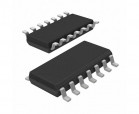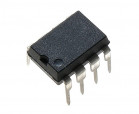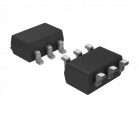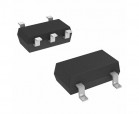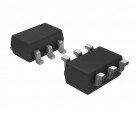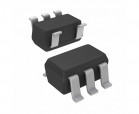Comparators (results: 310)
| Product | Cart |
Comparator type
|
Number of channels
|
Input offset voltage
|
Offset voltage
|
Propagation time
|
Operating temperature (range)
|
Nominal voltage
|
Output type
|
Mounting
|
|
|---|---|---|---|---|---|---|---|---|---|---|---|
|
LM239PW
Quad Voltage Comparator, tpd 1300ns, Voff 2mV, +/-1÷+/-18V, -25÷125°C
|
|||||||||||
|
|
Item available on a request
|
||||||||||
|
LM319
Dual Voltage Comparator; tpd 80ns; Voff 2mV; 5V~36V; +/-1.5÷+/-15V; 0÷70°C; Substitute: (LM119 -55÷125°C); (LM219 -25÷85°C); LM319N/NOPB;
|
|||||||||||
| Differential | 2 | 10nA | 8mV | 80ns | 0°C ~ 70°C | 5V ~ 36V | Open Collector | THT | |||
|
|
Item available on a request
|
||||||||||
|
LM319M Texas Instruments
Dual Voltage Comparator; tpd 80ns; Voff 2mV; 5V~36V; +/-2,5÷+/-18V; 0÷70°C; Substitute: LM319M/NOPB; LM319MX/NOPB;
|
|||||||||||
| General Purpose | 2 | 200nA | 2mV | 80ns | 0°C ~ 70°C | 5V ~ 36V | Open Collector | SMD | |||
|
|
Item available on a request
|
||||||||||
|
LM393D Texas Instruments
Dual Voltage Comparator; tpd 1300ns; Voff 2mV; 2V~36V; +/-1÷+/-18V; 0÷70°C; Substitute: LM393DR; LM393D-TI;
|
|||||||||||
| Differential | 2 | 50nA | 5mV | 1300ns | 0°C ~ 70°C | 2V ~ 36V | CMOS | SMD | |||
|
|
Item available on a request
|
||||||||||
|
LM393N/NOPB Texas Instruments
Dual Voltage Comparator; tpd 700ns; Voff 1mV; 2V~32V; +/-1÷+/-18V; 0÷70°C; Substitute: LM393N; LM393N/NOPB;
|
|||||||||||
| General Purpose | 2 | 50nA | 5mV | 700ns | 0°C ~ 70°C | 2V ~ 36V | CMOS | THT | |||
|
|
Item available on a request
|
||||||||||
|
LT6700IS6-1
Dual Voltage Comparator; 400mV Reference; tpd 18us; 1.4÷18V; -40÷85°C LT2700IS6-1/TRMPBF; LT6700IS6-1/TRPBF; LT6700IS6-1/TRM; LT6700IS6-1/PBF;
|
|||||||||||
| Low-power | 2 | 10nA | 6mV | 18000ns | -40°C ~ 85°C | 1,4V ~ 18V | Open Collector | SMD | |||
|
|
Item available on a request
|
||||||||||
|
TLV1701AIDCKT
Comparator Single R-R I/P ±18V/36V Automotive Medical 5-Pin SC-70 T/R TLV1701AIDCKT
|
|||||||||||
|
|
Item available on a request
|
||||||||||
|
TPS3700DDCT
Window Comparator w/ Internal Ref. for OV/UV Det., tpd 18us, 1.8÷18V, -40÷125°C
|
|||||||||||
|
|
Item available on a request
|
||||||||||
|
MCP6561T-E/LT
Comparator Single R-R I/P 5.5V Automotive 5-Pin SC-70
|
|||||||||||
|
|
Item available on a request
|
||||||||||
|
MAX920EUK+
MAX920 Series 5.5 V 1 nA SMT Single General Purpose Comparator - SOT-23-5 MAX920EUK; MAX920EUK+; MAX920EUK+T;
|
|||||||||||
|
|
Item available on a request
|
||||||||||
Comparators
Comparators are circuits used to compare two voltages and indicate which one is higher. Due to their usefulness, they are employed in many installations, so there are devices with different parameters available on the market. Therefore, when choosing a voltage comparator, it's important to consider the conditions under which it will operate.
Voltage Comparators – Function and Operating Principles
A voltage comparator performs a simple yet crucial task in many installations. These integrated circuits are used to compare two voltages and determine which one is higher. The operating principle of these devices is also quite straightforward – voltage comparators compare a reference signal with an input signal and generate an output signal that indicates the result of the comparison. Due to high susceptibility to interference, which can complicate the measurement, integrated circuits often use a feedback loop to achieve operating hysteresis.
What Are the Key Parameters of Comparators?
Since there are different voltage comparators on the market offering various parameters, choosing the right circuit can be challenging. Therefore, it is helpful to know which product features to focus on to meet the needs of your installation. One of the most important parameters distinguishing comparators is the operating voltage range. This value defines the conditions under which the device will operate correctly. Comparators will accurately indicate which of the compared values is higher only if the input voltages are within the range specified by the manufacturer.
Other important parameters to consider when choosing comparators include propagation time (the time required to make the comparison) and operating temperature. Both values must be properly matched to the needs of the system to ensure the entire installation functions correctly.
Voltage Comparator Applications
Because comparators perform a very important function, they are used in a wide variety of installations. These integrated circuits can be found in devices such as:
- Measuring instruments – a voltage comparator is used in measurement systems to compare a signal with a reference value.
- Control systems – comparators can be used in the construction of thermostats or devices regulating other values, such as speed and lighting.
- Automotive electronics – a voltage comparator can be used in the construction of sensors and safety systems in vehicles.
It is important to remember that each system may require a different component, so when selecting comparators, you should pay attention to their key parameters. Our online store offers a wide range of products that cater to the needs of various installations.



